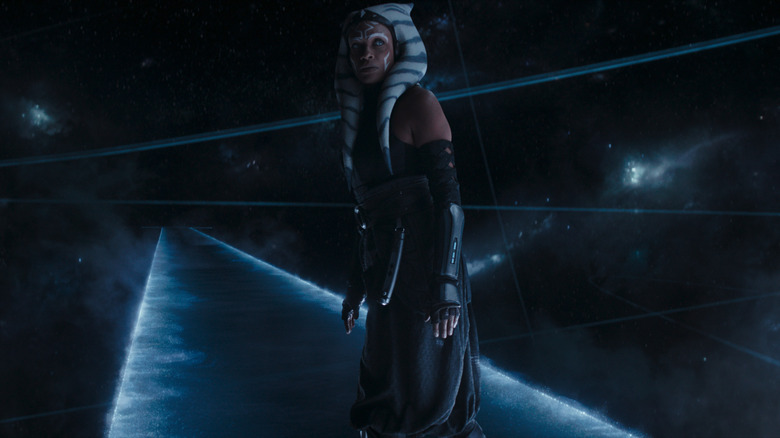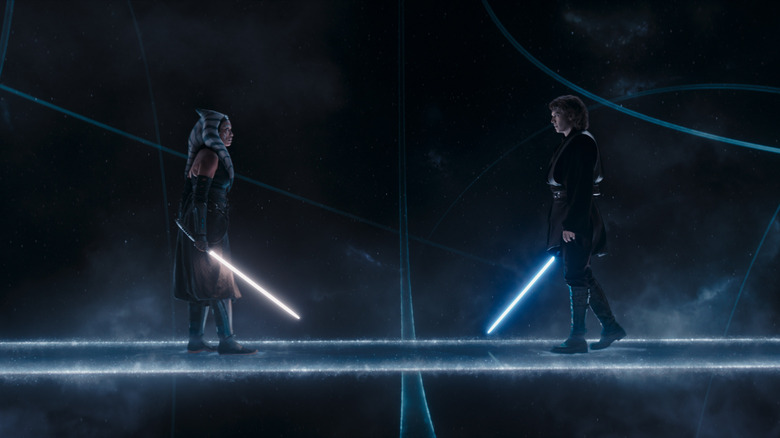Translating Ahsoka's World Between Worlds To Live-Action Was 'Highly Stressful'
The first season of "Ahsoka" on Disney+ delivered plenty for longtime "Star Wars" fans to enjoy, particularly those who love the animated shows. Dave Filoni, the creative force behind "The Clone Wars" and "Star Wars Rebels," was finally able to bring many of his creations to life in live-action. One of the most important things that the show's first season brought to life was the World Between Worlds, a hugely important plot device from the final season of "Star Wars Rebels." But making the mythical realm a tangible thing was no easy task.
Quyen Tran, one of two cinematographers who worked on "Ahsoka" season 1, spilled some of the show's secrets in the January 2024 edition of International Cinematographers Guild Magazine. "Translating that from animation to live-action was thrilling, but highly stressful," Tran said of making the World Between Worlds a reality. The realm shows up in a key episode after Rosario Dawson's Ahsoka Tano seemingly dies. She then finds herself in this realm between time and space, face to face with her old master Anakin Skywalker (once again played by Hayden Christensen). Speaking further, Tran dove into the painstaking creative process. As she said:
"I began by testing a physical platform where the action would be staged to see how light could pass up through it, and figure out how we could achieve camera angles set below that level to show exactly how this bridge exists in space. That discovery process was what led us to realize it couldn't be done using the volume without great compromise. Shooting from beneath would have placed our actors too near the ceiling, which wouldn't have worked given the issues with LED screens. So, we elected to build this on a traditional stage."
Making Star Wars fiction feel real
Filoni cut his teeth in a galaxy far, far away by crafting dozens of animated television episodes. The thing about animation is that the possibilities are pretty much endless. Its only true limits are budgetary and the talent of the team behind the project. That's what allowed the World Between Worlds to exist in the first place. Making that place real and tangible is another thing entirely.
Tran and the filmmakers ultimately decided against using the Volume, the groundbreaking technology pioneered in "The Mandalorian," which uses a dome full of screens to craft real-looking environments. Instead, they built an actual stage that allowed them to use multiple cameras which, in turn, let Dawson and Christensen flex their respective skills.
"We could shoot cross-coverage which allowed us to preserve the performances of our two actors using three Technocranes. Hayden is the best of all time with a lightsaber and wanted to perform his own stunts, so getting both sides of the combat was a big advantage because he didn't need to repeat all that action a second time, when we shot Rosario's side of the battle — that would have burned him out."
Tran added that using multiple cameras also let them "preserve the continuity of emotions that play out with these performers during the scenes." Tran, additionally, laid out the specifics of how they crafted the platforms that make up the World Between Worlds. Practical technology was used to craft a fictional place from the "Star Wars" galaxy.
"Working closely with Chief Lighting Technician Jeff Webster and [Key Rigging Grip] Bud Scott, we landed on the idea of using a grating for the platform that let us light from below with SkyPanels and Magic Cloth. That created the platform's glow; then, along the rim, we had three light strips that were controlled on the dimmer board. All that source lighting let us shoot the action practically, and it permitted cross-coverage."
"Ahsoka" season 1 is streaming now on Disney+.

